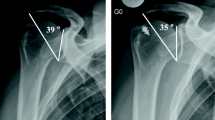Abstract
To define the bone’s amount that should be removed during an acromioplasty has always been a challenge. We aimed to verify the correlations between scapular dimensions and acromial thickness, assess the differences between the two genders, investigate the relationship between acromial type and thickness. We examined 500 dried scapulae, measuring the major axis of the scapular body and the acromial thickness; these were also catalogued according to gender. Acromial shape was classified according to Bigliani’s method. Frequencies: Type I 38.9 %, Type II 39.4 %, Type III 21.7 %. The mean acromial thickness was 0.85 cm, and it resulted wider in men. There was a direct linear relationship between scapular dimensions and acromial thickness. The range of thickness of Type III acromion was significantly different from the others. We should be aware that gender, scapular dimensions and acromial shape should be evaluated preoperatively since they influence the acromial thickness.



Similar content being viewed by others
References
Green A, Griggs S, Labrador D (2004) Anterior acromial anatomy: relevance to arthroscopic acromioplasty. Arthroscopy 20:1050–1105
Snyder JS (2003) Rotator cuff: introduction, evaluation, and imaging. In: Shoulder arthroscopy, 2nd edn. Lippincott Williams and Wilkins, Philadelphia, p 194
Gartsman GM (2003) Impingement syndrome. In: Shoulder arthroscopy. Elsevier, Philadelphia, p 181
Bigliani LU, Levine WN (1997) Current concepts review—subacromial impingement syndrome. J Bone Joint Surg Am 79:1854–1868
Bigliani LU, Morrison DS, April EW (1986) The morphology of the acromion and its relationship to rotator cuff tears. Orthop Trans 10:216
Chun JM, Yoo HW (1994) Incidence of acromial spur. J Shoulder Elbow Surg 3:S20
Edelson JG, Taitz C (1992) Anatomy of the coraco-acromial arch: relation to degeneration of the acromion. J Bone Joint Surg Br 74:589–594
Epstein RE, Schweitzer ME, Frieman BG, Fenlin JM, Mitchell DG (1993) Hooked acromion: prevalence on MR images of painful shoulders. Radiology 187:479–481
Farley TE, Neumann CH, Steinbach LS, Petersen SA (1994) The coracoacromial arch: MR evaluation and correlation with rotator cuff pathology. Skeletal Radiol 23:641–645
Gagey N, Ravaud E, Lassau JP (1993) Anatomy of the acromial arch: correlation of anatomy and magnetic resonance imaging. Surg Radiol Anat 15:63–70
Gill TJ, McIrvin E, Kocher MS, Homa K, Mair SD, Hawkins RJ (2002) The relative importance of acromial morphology and age with respect to rotator cuff pathology. J Shoulder Elbow Surg 11:327–330
Hirano M, Ide J, Takagi K (2002) Acromial shapes and extension of rotator cuff tears: magnetic resonance imaging evaluation. J Shoulder Elbow Surg 11:576–578
Nastis K, Tsikararas P, Totlis T, Gigis I, Skandalakis P, Appel HJ et al (2007) Correlation between the four types of acromion and the existence of enthesophytes: a study on 423 dried scapulas and review of the literature. Clin Anat 20:267–272
Neer CS II (1972) Anterior acromioplasty for the chronic impingement syndrome in the shoulder: a preliminary report. J Bone Joint Surg Am 54:41–50
Nicholson GP, Goodman DA, Flatow EL, Bigliani LU (1996) The acromion: morphologic condition and age-related changes. A study of 420 scapulas. J Shoulder Elbow Surg 5:1–11
Ogata S, Uhthoff HK (1990) Acromial enthesopathy and rotator cuff tear. Clin Orthop 254:39–48
Oh JH, Kim JY, Lee HK, Choi JA (2010) Classification and clinical significance of acromial spur in rotator cuff tear: heel-type spur and rotator cuff tear. Clin Orthop 468:1542–1550
Ozaki J, Fujimoto S, Nakagawa Y, Masuhara K, Tamai S (1988) Tears of the rotator cuff of the shoulder associated with pathological changes in the acromion. J Bone Joint Surg Am 70:1224–1230
Paraskevas G, Tzaveas A, Papaziogas B, Kitsoulis P, Natsis K, Spanidou S (2008) Morphological parameters of the acromion. Folia Morphol (Warsz) 67:255–260
Shah NN, Bayliss NC, Malcolm A (2001) Shape of the acromion: Congenital or acquired—a macroscopic, radiographic, and microscopic study of acromion. J Shoulder Elbow Surg 10:309–316
Speer KP, Osbahr DC, Montella BJ, Apple AS, Mair SD (2001) Acromial morphotype in the young asymptomatic athletic shoulder. J Shoulder Elbow Surg 10:434–437
Toivonen DA, Tuite MJ, Orwin JF (1995) Acromial structure and tears of the rotator cuff. J. Shoulder and Elbow Surg 4:376–383
Wang JC, Shapiro MS (1997) Changes in acromial morphology with age. J Shoulder Elbow Surg 6:55–59
Zuckerman JD, Kummer FJ, Cuomo F, Simon J, Rosenblum S (1992) The influence of the coraco-acromial arch anatomy on rotator cuff tears. J Shoulder Elbow Surg 1:4–14
DePalma (1973) Normal regional and variational anatomy of the shoulder. In: Surgery of the shoulder, 2nd edn. Lippincott, Philadelphia, pp 45–48
Gumina S, Albino P, Giaracuni M, Vestri AR, Ripani M, Postacchini F (2011) The safe zone for avoiding suprascapular nerve injury during shoulder arthroscopy: an anatomical study on 500 dry scapulae. J Shoulder Elbow Surg 20:1317–1322
Bigliani LU, Dasley RM, McCann PD, April EW (1990) An anatomical study of the suprascapular nerve. Arthroscopy 6:301–305
Getz JD, Recht MP, Piraino DW, Schils JP, Latimer BM, Jellema LM et al (1996) Acromial morphology: relation to sex, age, symmetry, and subacromial enthesophytes. Radiology 199:737–742
Churchill RS, Brems JJ, Kotschi H (2001) Glenoid size, inclination, and version: an anatomic study. J Shoulder Elbow Surg 10:327–332
Checroun AJ, Hawkins C, Kummer FJ, Zuckerman JD (2002) Fit of current glenoid component designs: an anatomic cadaver study. J Shoulder Elbow Surg 11:614–617
Merrill A, Guzman K, Miller SL (2009) Gender differences in glenoid anatomy: an anatomical study. Surg Radiol Anat 31:183–189
Penning R, Muller S (1988) Sexual dimorphism of the scapula. Z Rechtsmed 101:183–196
Conflict of interest
None.
Author information
Authors and Affiliations
Corresponding author
Rights and permissions
About this article
Cite this article
Gumina, S., Albino, P., Carbone, S. et al. The relationship between acromion thickness and body habitus: practical implications in subacromial decompression procedures. Musculoskelet Surg 96 (Suppl 1), 41–45 (2012). https://doi.org/10.1007/s12306-012-0194-3
Received:
Accepted:
Published:
Issue Date:
DOI: https://doi.org/10.1007/s12306-012-0194-3




